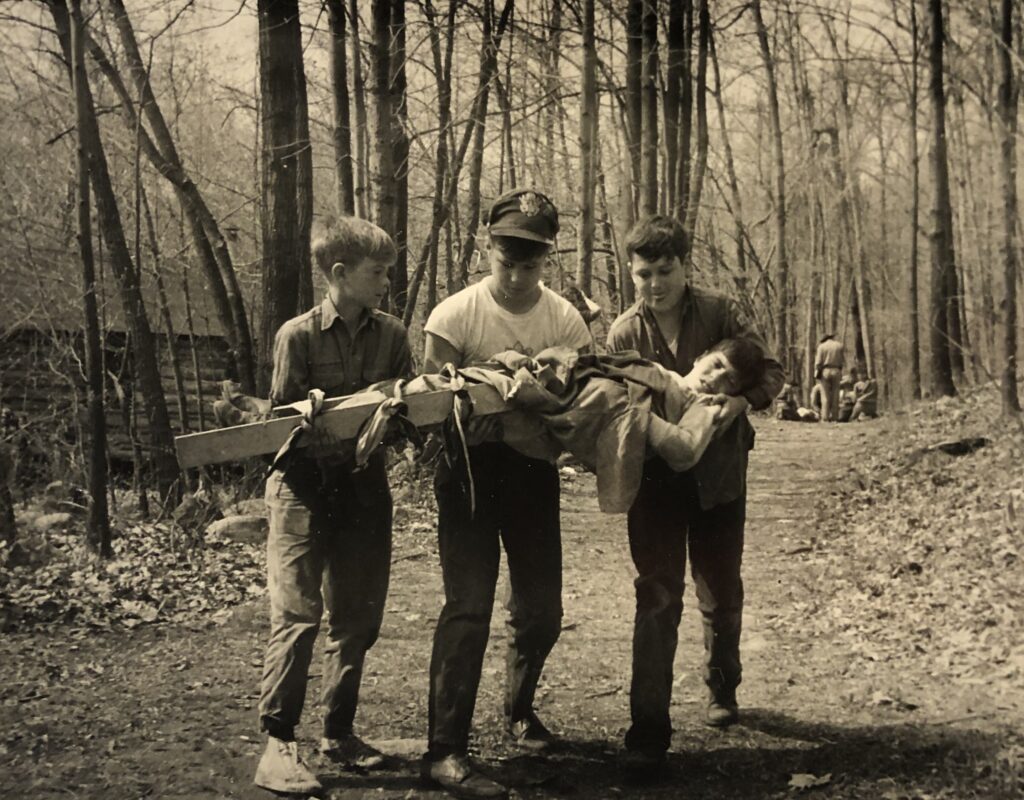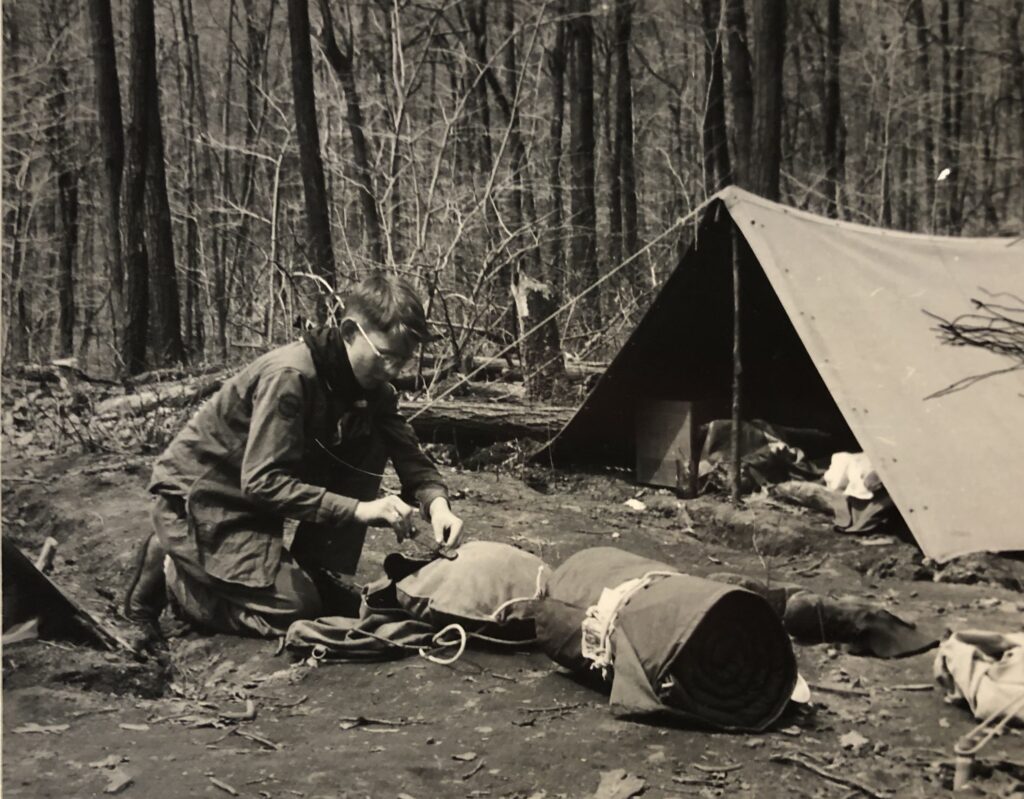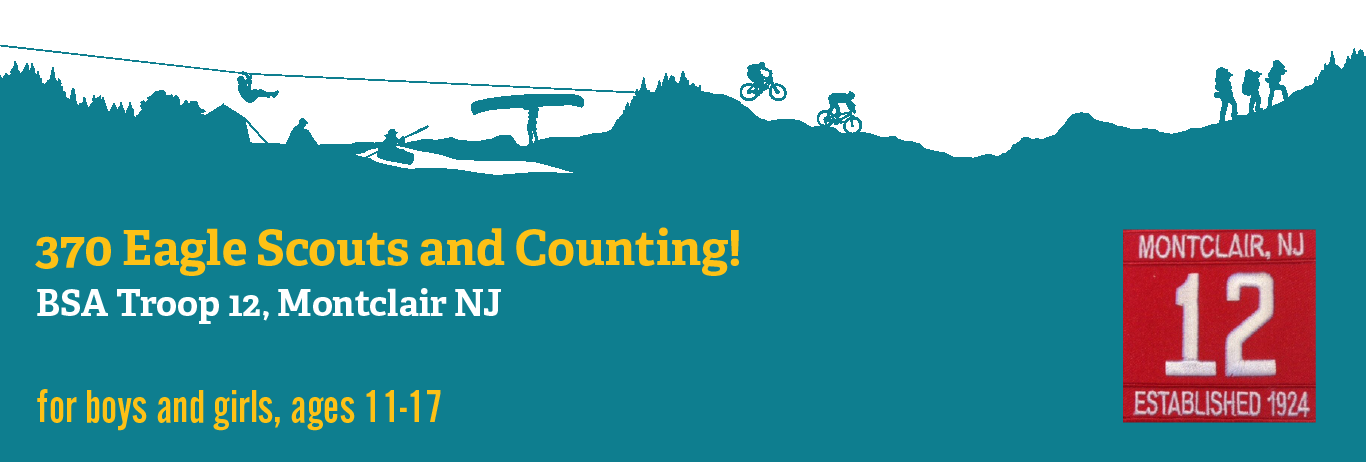History of Troop 12 Montclair
January 2020 – Updated Oct 2023
Dedicated to Osborne Taylor, Jeff Gaskin, Dr. Norman Leard III, and all the Troop 12 scouts of tomorrow.

The origins of Troop 12 Montclair date back to before 1924, when it was founded as a troop in the Boy Scouts of America, but it dates back even before the founding of the Boy Scouts of America (now BSA Scouts) in 1910. Before that date, there were many separate and independent organizations that operated similarly to how the Boy Scouts operates, dedicated to exposing young boys to the outdoors and survival activities. In Montclair, for example, the YMCA held an annual Camp at Lake Wawayanda in Vernon beginning in 1886. In 1910, Ernest Thompson Seton, who had founded the Boy Scouts of America earlier in the year, spoke in the new Hillside Grammar School auditorium, galvanizing a public already interested in such ideas. In Montclair, there were four people who had organized troops like this: Frank Fellows Gray (a friend of Baden-Powell’s and leader at Wawayanda, founder of Troop 4), George A. Hall (founder of Troop 2), Theodore Dorman (founder of Troop 13), and Captain Harold Wilson Armstrong. Sometime in 1911 or 1912, Captain Armstrong organized a troop (Troop 9) at the Watchung Elementary School in Montclair. Armstrong passed away in late 1916, but there are mentions of the Troop’s activities throughout the late 1910s and early 1920s, a time in which scouting was very popular in town. In April, 1924, under the leadership of its first scoutmaster David Paine, a lawyer, Troop 12 split off from Troop 9 which was at capacity. When it was first officially founded, Troop 12 was sponsored by the Watchung Congregational Church and met at Watching Elementary School. From 1924 to 1925, it was led by Paine with help from George H. McNeal and Josiah Burt (sometimes spelled Bert) Green man, who had previously run Troop 9. Frederick A. MacNutt became Scoutmaster in 1925 and Alfred C. Fromhold took over 1926, when Watchung School assumed sponsorship. In 1927, McNeal served as Scoutmaster, followed by Burt Greenman in 1929.
Scoutmasters of Troop 12:
David Paine, founder, 1924-1925
F. A. Macnutt, 1925
Alfred C. Fromhold, 1926-1927
George McNeal, 1927-1929
Burt Greenman, 1929
O. K. Taylor, 1930-1980
Dr. Norman Leard III, 1980-2001
Jeff Gaskin, 2001-2015
Greg Spinelli (co-scoutmaster), 2001-2011
Eric Umar (co-scoutmaster), 2011-2015
Carl Joslyn, 2015-2020
Dan Buckley, 2019-
Jen Bell, 2023-

From January 1st, 1930 to June 30th, 1980, the troop was led by Osborne K. (“O.K.”) Taylor. O. K. Taylor was a Sunday school teacher for a scout named a scout named Alex Inlay, who recommended him to lead the troop when Burt Greenman could not continue. According to one scout, Lou Cushman, “To me Troop 12 is and always will be O.K Taylor, and of him, the memories will always live.” O. K. was born in May of 1900 and had to drop out of Montclair High School to help support his family at age 16. He got a job at Standard Oil as an office boy and attended night school at Columbia University to earn his education. By 1933, he would be manager of the securities division, retiring in 1959 as assistant deputy treasurer of the company. When Taylor first became scoutmaster, he didn’t know much about scouting, but he enlisted two Eagle Scouts from another troop to help out. With the help of the Eagle Scouts and experience in business, the troop took off: Taylor recruited adults, gave them tasks, and then held meetings to show the importance of those tasks. O. K.’s list of accomplishments is impressive: he wrote a portion of the Scout handbook on the Patrol Method, which he was an expert on, and was on the National Board of Trustees. He was awarded the Silver Beaver medal from the Council and the Silver Antelope from the Northeast Region of the BSA. He was awarded the Silver Buffalo award, the highest honor a volunteer can earn, and lectured to a district and national group about leadership. Most of the troop’s schedule today is still based on the work of O. K. Taylor. During his tenure, 1,357 scouts joined, 580 became Star, 380 became Life, and 230 became Eagle Scouts.
Since O. K. took the helm in 1930, Troop 12 has followed the Boy Scouts of America program closely, with a special emphasis on three areas: camping, personal advancement, and leadership training. O. K. created a troop schedule that is still adhered to: two major camping trips, one in spring and once in fall, as well as three training conferences a year, and after each weekly troop meeting a staff conference where they discussed programs, training, and personal problems.

Troop 12 has always focused strongly on camping, first leasing Camp Wyanokie in West Milford, New Jersey in 1933. The troop camped there for many years, having many great camping experiences. In 1947, the troop moved to Camp Glen Gray in Mahwah, New Jersey, the Eagle Rock council’s campsite, established by Frank Fellows Gray, also of Montclair and a key figure in the scouting movement. O. K. Taylor first got permission from the council to build a cabin in 1947, and it was completed in 1949 under the supervision of Ed Smith, an engineer at Bell Labs with the assistance of]Mel Stecher, Bill Mutch, Bill Street, Mr. Cole, Mr. Erb, Mr. Forestal and many more including mothers of some scouts. Funding for the cabin was in part provided by the Scout Mother’s Association, who held bake sales, fashion shows and other fundraisers. The kitchen cabinets were made in Montclair by Ed Smith, and brought up to Glen Gray in the troop truck. Still in use, over seventy years later, the Troop 12 cabin at Camp Glen Gray has been one of our most important assets. We hold training camps, round robins, and participate in competitions there. It is the primary way that the troop gets into the wilderness, and it took a lot of work to build it. When it was being furnished, all the supplies had to be carried by hand up to the cabin, as the road only went halfway up the hill! Even the heavy, cast iron stoves had to be carried by sled. The stove in the main room of the cabin was installed with special funds from Mr. Hudig in memory of his son, Carl. The other stove in the bunk room was donated by the Glenn family in memory of their son, Everett. In the early days scouts would take a train from Montclair to the old Midvale, NJ station and then hike the five miles to the camp, carrying their gear (see Marty Suydam’s recollections of scouting days under O. K. Taylor).

Sometime in 1980, the troop started going to Crossett Lake in New York for summer camp, which was maintained by their council. Dr. Leard took them here for 2 weeks every summer for 14 years. At this time, they broadly expanded their program there. Dr. Leard had three programs; one for new scouts aiming to get through the Tenderfoot and 2nd Class rank, one for scouts aged 12 and 13 which entailed a canoe trip to Lake George, and one for advanced scouts aged 14 and older which entailed 50-mile canoe trip and sailing. When the council sold the camp, the troop went to Keowa, where we still go today. However, for a brief period of time, we went to a different camp called Camp Rodney on the Chesapeake River after Keowa had changed their program. When they changed it back, we started going back there.
Leadership training and citizenship have both always been a big part of Troop 12’s ‘curriculum’ of sorts. Troop 12 has developed and maintained leadership activities and conferences to help aid scouts as well as their patrol leaders and assistant patrol leaders. One scout said, “When I first joined the Scouts and we went on an overnight, I thought Scouting was about camping, but I finally discovered it’s really about citizenship.” In addition, an advancement system was introduced early on. Adults would teach badges at the weekly troop meetings, and this produced many Eagle Scouts. An inter-troop patrol competition was established, and patrols could earn points by attendance, advancement, and troop and camping events. In June, the patrol with the most points was awarded a cup with the patrol name engraved on it. This system is still in use today.

When he traveled for business, Taylor recruited scouters to take care of his duties. While traveling, the plane he was on hit an air pocket and dropped 2,000 feet, and he ended up in a Swiss hospital with a broken back for 2 months. Luckily, three adults quickly took his place temporarily: Bill McMillan, Eric Graber, and Dr. Norman (“Doc”) Leard, who would later succeed him as scoutmaster. Born in December 1933, Leard joined Troop 12 in 1945 as an Arrow of Light Cub Scout from Pack 12. He rose through the ranks and earned Eagle Scout in 1950, and after receiving his education and marrying, he came back to the Troop in 1958 with the hopes of teaching a merit badge. In October of that year, he was installed as assistant scoutmaster, a role he served for twenty-two years. He got involved in district events through his first aid training and eventually became the District Chairman in 1976. For his efforts, he received the Silver Beaver award and took leadership training courses. To the troop curriculum, he added the historic hike in the fall and the historic bus trip in the spring to places like the Freedom Trail in Boston, Annapolis, West Point, Brandywine, Mystic and the submarine base at Groton, CT. He was also elected permanent Patrol Leader of his patrol and earned wood badge beads with Frank Krannick.
In 1980, after O. K. Taylor had celebrated his fiftieth anniversary leading the troop, the troop committee came to Dr. Norman Leard and asked him to take over the leadership. He accepted under the condition that O.K. would serve as Assistant Scoutmaster, a position which O.K. held from 1981 until 1990, when he died of cancer at age 88. His 3 eulogists were John McMullen, a naval architect, and owner of the New Jersey Devils, Dr. Leard, and John Whitehead, a former managing director at Goldman Sachs and Deputy Secretary of State under President Reagan, all scout related. In the 1980s the Montclair Board of Education decided to not allow the extra use of the elementary school to help minimize expenses. Scoutmaster Leard went to the Board of Education and asked if they could use Mt. Hebron Middle School (now named Buzz Aldrin after the astronaut and former member of Troop 12), and the troop met on Fridays, except when the school had an event and the troop would meet on Tuesdays. There was very low attendance on the school nights. Because of this, the scoutmaster went to the manager of Montclair Kimberly Academy Middle School and negotiated a deal of $10 per week to use the gym. However, when a new manager came, the cost went up to $30, and the troop looked for another alternative. Dr. Leard asked the rector at St. James Church, Dr. Thomas Travis, if they would like to host our troop, and they welcomed us with open arms.

After Dr. Leard resigned, he recruited two successors: Jeff Gaskin, the first African-American Scoutmaster of our troop and Greg Spinelli. Born in Montclair, Gaskin had previously served as leader of Cub Scout Pack 5, and while there, took a brave and public stand against a nationwide policy to exclude gay Scout leaders. 10 years later, Spinelli resigned and was replaced by Erich Umar. At the end of 2015, both Gaskin and Umar resigned and were replaced by Carl Joslyn, who turned over the reins to Daniel Buckley in 2019, who is the scoutmaster today. Sadly, Scoutmaster Gaskin passed away in 2018.
Members of Troop 12 have taken the opportunity to attend national scouting jamborees, as well as international ones like in England, France, Sweden, and Austria. Members of the troop have participated in hikes at places like Philmont Scout Reservation in New Mexico. The troop has also gone on hikes to places like Gettysburg, Valley Forge, and spots closer to home.
Greg Spinelli (L) and Jeff Gaskin (R)
As Troop 12 has lasted almost 100 years as a Boy Scout troop, it has seen some of America’s worst moments; The Great Depression, Segregation and Jim Crow laws, World War 2, the Vietnam and Korean Wars, the Cold War, 9/11, COVID, and a multitude of others. For example, during World War 2, the shortages on gas and tires prevented scouts from taking trips except those accessible by train which forced the scouts to walk long distances from the station to the camping area. The film shortage prevented picture taking and documentation of that nature. However, the troop persevered. At all times it has tried to stick to its ‘curriculum’, due mostly to its effective leadership under people like O.K. Taylor and the volunteers who helped perpetuate the troop’s existence. They built the Glen Gray cabin and help maintain it, they teach our merit badges, give us guidance running it, and help donate their resources so when can continue to operate. Saint James Church in Upper Montclair has been a huge help, allowing us to effectively and consistently operate, hosting all of our troop meetings and Patrol Leader Councils, and even some patrol meetings.
More recently, Troop 12 has seen the Boy Scouts change their program to allow girls to participate equally. Now named Scouts BSA, Troop 12 has expanded the program, forming a troop for girls, led by longtime Committee member, now Scoutmaster, Jennifer Bell. The girls and boys hold joint meetings and activities, compete for the Patrol Cup, hold Training Conferences and attend camp at Keowa together, all benefiting from the Troop 12 curriculum and experience.
Troop 12 has built up a history of great scouting, which has allowed us to produce many Eagle Scouts over the years and produce many happy campers (literally).
Information courtesy of Norman Leard, Troop records, and from the Montclair Times.
